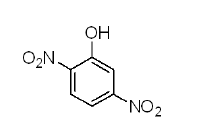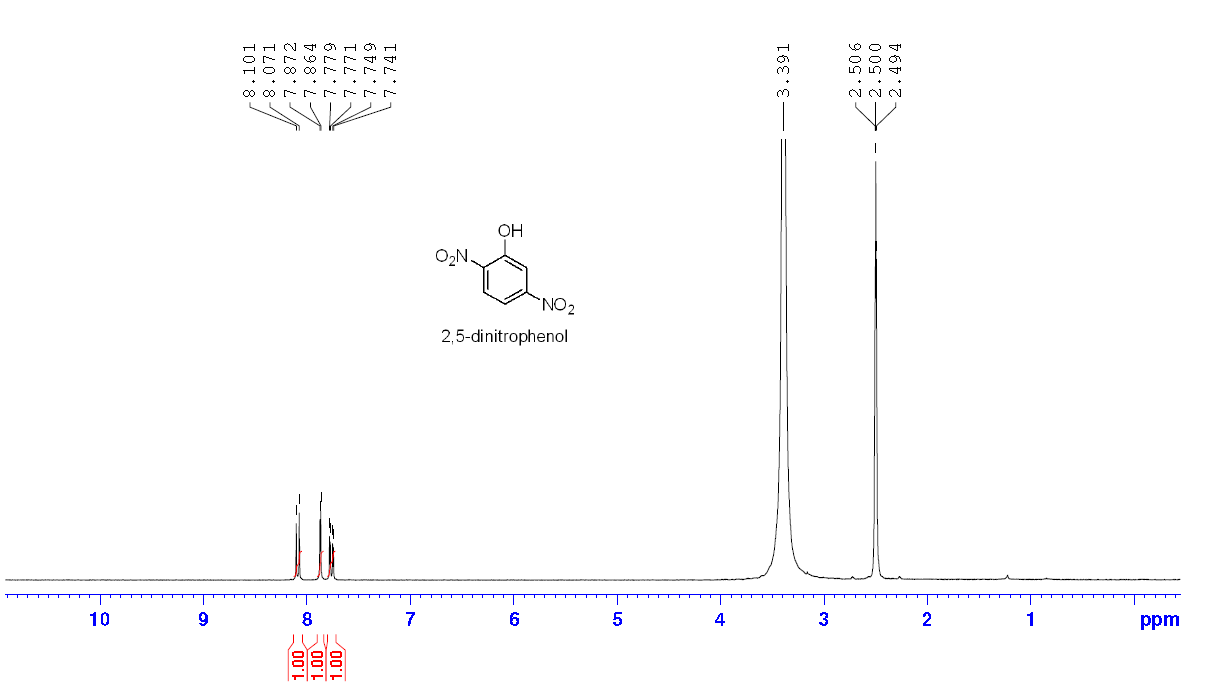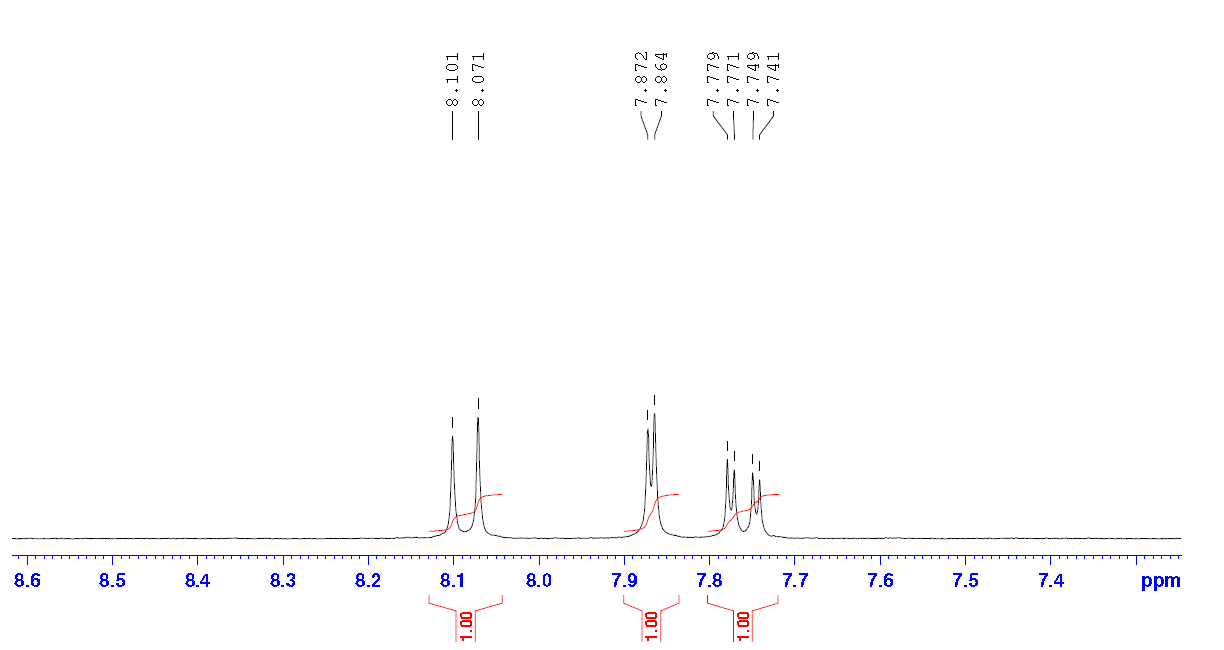2,5-DINITROPHENOL CAS#: 329-71-5; ChemWhat Code: 96513
Identification
| Product Name | 2,5-DINITROPHENOL |
| IUPAC Name | 2,5-dinitrophenol |
| Molecular Structure |  |
| CAS Registry Number | 329-71-5 |
| EINECS Number | 206-348-1 |
| MDL Number | MFCD00007108 |
| Beilstein Registry Number | 1913411 |
| Synonyms | 2,5-dinitrophenol2,5-DNP2,4-dinitrophenol |
| Molecular Formula | C6H4N2O5 |
| Molecular Weight | 184.106 |
| InChI | InChI=1S/C6H4N2O5/c9-6-3-4(7(10)11)1-2-5(6)8(12)13/h1-3,9H |
| InChI Key | UWEZBKLLMKVIPI-UHFFFAOYSA-N |
| Canonical SMILES | c1cc(c(cc1[N+](=O)[O-])O)[N+](=O)[O-] |
| Patent Information | ||
| Patent ID | Title | Publication Date |
| US2013/316985 | GPR35 Ligands And Uses Thereof | 2013 |
| US2002/1015 | Compositions comprising cyclodextrin | 2002 |
Physical Data
| Appearance | Yellow or pale yellow solid |
| Solubility | No data available |
| Flash Point | No data available |
| Refractive index | No data available |
| Sensitivity | No data available |
| Melting Point, °C | Solvent (Melting Point) |
| 108 – 109 | ethyl acetate, hexane |
| 105.5 – 106 | |
| 105.7 | H2O |
| 106.1 – 106.3 |
| Density, g·cm-3 | Measurement Temperature, °C |
| 1.76 | -173.16 |
| Description (Association (MCS)) | Solvent (Association (MCS)) | Temperature (Association (MCS)), °C | Partner (Association (MCS)) |
| Stability constant of the complex with … | dioxane | 25 | triethylamine |
| Stability constant of the complex with … | chlorobenzene | 24.9 | triethylbenzylammonium 2,4-dinitrophenoxide |
| Stability constant of the complex with … | acetonitrile | 25 | tetrabutylammonium 2,5-dinitrophenolate |
| NMR spectrum of the complex | CD3CN | 25 | Triphenylphosphine oxide |
Spectra
| Description (NMR Spectroscopy) | Nucleus (NMR Spectroscopy) | Solvents (NMR Spectroscopy) | Temperature (NMR Spectroscopy), °C | Frequency (NMR Spectroscopy), MHz |
| Chemical shifts | 1H | deuterated dimethyl sulfoxide | ||
| Chemical shifts | 13C | solid | 50.3 | |
| Chemical shifts | 13C | CDCl3 | 25 | |
| NMR |
| Description (IR Spectroscopy) | Solvent (IR Spectroscopy) | Comment (IR Spectroscopy) |
| Bands, Spectrum | potassium bromide | |
| Bands | KBr | 1552 – 818 cm**(-1) |
| Intensity of IR bands |
| Description (Mass Spectrometry) |
| spectrum, electron impact (EI) |
| chemical ionization (CI), spectrum |
| Description (UV/VIS Spectroscopy) | Solvent (UV/VIS Spectroscopy) | Comment (UV/VIS Spectroscopy) | Absorption Maxima (UV/VIS), nm | Ext./Abs. Coefficient, l·mol-1cm-1 |
| Spectrum | acidic aq. solution | Remark: from 25 to 175 deg C | ||
| various solvent(s) | Remark: pH 10.35 | 283, 444 | 8248, 4225 |
Route of Synthesis (ROS)

| Conditions | Yield |
| With triethylamine In chloroform at 20℃; for 14.5h; Reflux; Experimental Procedure 2,4-Dinitrophenyl ester of propionic acid (7) General procedure: Into a three-necked round-bottomed flask equipped with a mechanical stirrer, a reflux condenser, and a dropping funnel, 0.1 mol of 2,4-dinitrophenol, 70 mL of chloroform, and 15 mL of triethylamine were placed. Into the solution thus obtained, 0.1 mol of propionic acid chloride was added dropwise with vigorous stirring for 30 min. The resulting mixture was stirred for 2 h at room temperature and then refluxed for 12 h. Next the solvent was distilled off, whereupon the residue was transferred into ice-cold water and left for 2 h. The product was filtered off, washed with water, and dried. For purification the product was recrystallized from ethanol and subjected to column chromatography over silica gel (eluent chloroform). | 88% |
Safety and Hazards
| Pictogram(s) |    |
| Signal | Danger |
| GHS Hazard Statements | H301 (97.62%): Toxic if swallowed [Danger Acute toxicity, oral] H311 (97.62%): Toxic in contact with skin [Danger Acute toxicity, dermal] H331 (97.62%): Toxic if inhaled [Danger Acute toxicity, inhalation] H373 (100%): Causes damage to organs through prolonged or repeated exposure [Warning Specific target organ toxicity, repeated exposure] H411 (100%): Toxic to aquatic life with long lasting effects [Hazardous to the aquatic environment, long-term hazard] Information may vary between notifications depending on impurities, additives, and other factors. |
| Precautionary Statement Codes | P260, P261, P264, P270, P271, P273, P280, P301+P316, P302+P352, P304+P340, P316, P319, P321, P330, P361+P364, P391, P403+P233, P405, and P501 (The corresponding statement to each P-code can be found at the GHS Classification page.) |
Other Data
| Transportation | NONH for all modes of transport |
| Under the room temperature and away from light | |
| HS Code | No data available |
| Storage | Under the room temperature and away from light |
| Shelf Life | 2 years |
| Market Price | USD |
| Druglikeness | |
| Lipinski rules component | |
| Molecular Weight | 184.108 |
| logP | 2.258 |
| HBA | 0 |
| HBD | 1 |
| Matching Lipinski Rules | 4 |
| Veber rules component | |
| Polar Surface Area (PSA) | 111.87 |
| Rotatable Bond (RotB) | 2 |
| Matching Veber Rules | 2 |
| Use Pattern |
| 2,5-DINITROPHENOL CAS#: 329-71-5 used as raw material for organic chemicals. |
Buy Reagent | |
| No reagent supplier? | Send quick inquiry to ChemWhat |
| Want to be listed here as a reagent supplier? (Paid service) | Click here to contact ChemWhat |
Approved Manufacturers | |
| Watsonnoke Scientific Ltd | https://www.watsonnoke.com/ |
| Want to be listed as an approved manufacturer (Requires approvement)? | Please download and fill out this form and send back to approved-manufacturers@chemwhat.com |
Contact Us for Other Help | |
| Contact us for other information or services | Click here to contact ChemWhat |


